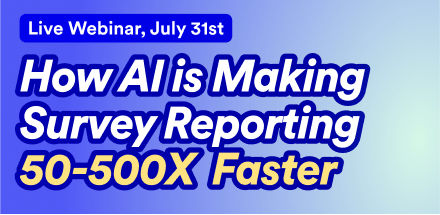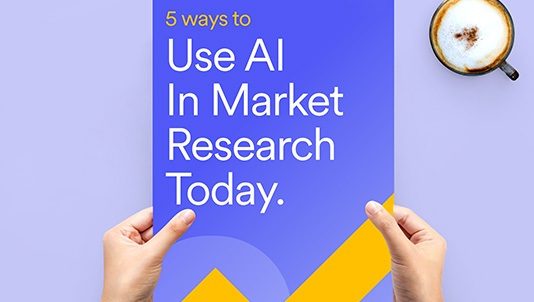

AI Market Research: 2025 State of Play
How do you quantify the impact AI has had on market research? It's hard to say. However, Displayr recently straw-polled a group of market researchers on the topic, with around 85% of respondents confirming AI has already been useful. Many even described it as a game-changer.
But how exactly is AI being used by researchers to change the game? Who are the major players? What's next? And most importantly, how can you implement AI effectively to start realizing the benefits today? This is your comprehensive guide to AI in market research, designed to help you succeed in this ever-changing field.
The History of AI & Market Research
When the discussion moves towards the topic of AI in market research, it is often spoken about as if it is an entirely new concept. And while many of the most transformative use cases of AI have emerged in the last few years, it is important to remember that the concept of artificial intelligence and machine learning has played an important role in market research for some time now.
Before the rise of generative AI, researchers were already leveraging machine learning for tasks like predictive analytics, segmentation, and churn modeling. Text analysis tools utilized natural language processing (NLP) to automatically or semi-automatically code open-ended responses at scale, and recommendation algorithms helped optimize pricing, messaging, and product configurations. These earlier forms of AI automated repetitive tasks, uncovered hidden patterns in data, and supported faster, more accurate decision-making, laying the groundwork for the more advanced, conversational AI tools we see today.
AI-Powered Market Research In Action
And while it was clear the impact AI could have on market research, it wasn't until generative AI became a mainstay that the genie was released from the bottle. Market research is typically divided into five steps: defining objectives, creating a plan, data collection, data analysis, and reporting. Across each of these steps, we've seen generative AI have an impact.
- Define objectives: AI tools can now assist in identifying emerging trends and consumer needs by analyzing vast amounts of social media, customer feedback, and market data—helping researchers frame sharper, more relevant research questions.
- Create a plan: Generative AI can speed up the research design process by drafting surveys, discussion guides, and sampling strategies. It can even recommend the best methodologies based on past project data or industry benchmarks.
- Data collection: While traditional tools like survey platforms still do the heavy lifting here, generative AI is increasingly used to personalize surveys in real time, simulate responses during pretesting, or create synthetic datasets when actual data is sparse.
- Data analysis: This is where generative AI truly shines—summarizing open-ended responses, identifying key themes, suggesting hypotheses, and even writing entire analysis narratives. It dramatically reduces the manual effort of coding and interpreting complex data.
- Reporting: Generative AI can instantly produce draft reports, create executive summaries, write PowerPoint slides, and generate visualizations. It empowers researchers to move from data to story much faster—without compromising on depth or accuracy.
Can AI Create and Conduct A Survey?
As mentioned above, AI is taking hold of the data collection process—blurring the lines between surveys and interviews. AI-moderated research takes the concept of traditional user research (one-on-one conversations, open-ended questions, in-depth answers) and applies the scale automation. This means that rather than spending hours conducting a handful of interviews, researchers can get these same in-depth findings with a fraction of the effort. And with natural language processing constantly evolving, the AI can effortlessly steer the conversation with the guile of a human interviewer.
You can read more about the synthesis of quantitative and qualitative research here.
AI and surveys are a double-edged sword, however. While researchers can use automation to fast-track data collection, respondents can use this same technology to fill out surveys in a matter of seconds, creating huge data integrity problems. AI-powered survey fraud is real and it is on the rise. If you are conducting a survey (especially one with lots of open-ended questions), be sure to take time to look at the answers properly and make a judgment on the likelihood of there being survey fraud. The video below explains how Displayr can be set up to detect fraudulent responses.
The Rise of Synthetic Data
AI-powered survey data is an issue if it's fraudulent, but what if it's been carefully designed to replicate real-world data?
Synthetic data is one of the more polarizing use cases to emerge when it comes to AI in market research. It is exactly what it sounds like—artificially generated responses that mimic real-world factors and can be customized as required. Ideally, synthetic data is used to supplement primary research if there has been a shortfall in responses collected. For example, if you needed to collect 500 responses and only managed to gather 450, synthetic data could be used to generate the outstanding responses. This is not dissimilar to the process of imputing missing data, which has previously been used by researchers.
In theory, it is a highly effective way to leverage AI to increase sample sizes and reduce associated costs. However, it does bring with it problems around bias and data integrity. AI's tendency to 'hallucinate' means there may be problems with the quality of the data. To reduce issues associated with synthetic data, it should always be trained on a high-quality 'real' dataset.
Learn more about some of the other misnomers around AI in market research here.
Top AI Market Research Companies
Such has been the tidal wave of AI, it is hard to differentiate between AI market research companies and non-AI market research companies at this point. However, there are some leaders in the space who have revolutionized how AI fits in with research.
Displayr: Today, AI is at the core of Displayr's functionality. AI text categorization helps researchers generate insights from open-ended data in seconds. Additionally, the AI R Code Writer lets you use AI to generate code directly into the Code Editor, making it easier to customize your analysis. You can see a more detailed outline of Displayr's AI capabilities.
NielsenIQ: A global leader in consumer intelligence, using AI for retail analytics, forecasting, and automated insight generation across massive datasets spanning sales, media, and shopper behavior.
Ipsos: One of the world’s largest market research firms, incorporating AI in areas like emotion recognition, social media listening, and automated ad testing to deliver agile insights at scale.
GfK (an NIQ company): Blends traditional research expertise with AI-driven analytics in areas like brand tracking and product optimization, offering predictive insights powered by machine learning.
Kantar: A long-standing research powerhouse applying AI in media measurement, brand lift studies, and open-ended text analysis—transforming how global brands track and respond to consumer sentiment.
Want a more detailed look? Check out Displayr's list of the 14 best AI market research tools for smarter insights.
AI-Powered Market Research: A Step-by-Step Guide
AI is no longer a bonus feature in market research—it’s becoming a core part of how projects are designed, executed, and delivered. Here’s how researchers are reimagining the research process with AI at every stage:
1. Sharpening the Brief: Before any data is collected, AI can synthesize background materials, identify category trends, and highlight knowledge gaps—helping researchers write better briefs and align stakeholders faster.
2. Building the Framework: Survey and research design tasks are becoming faster and more intuitive. AI can draft survey questions, flag potential biases, and even recommend sample structures based on past success.
3. Smarter Collection: While AI doesn’t replace the need for respondents, it improves the experience. Think: optimized question order, real-time language adjustments, or chatbot-style surveys that feel more conversational and engaging.
4. Accelerated Analysis: Gone are the days of manually coding thousands of open-ended responses. AI now summarizes themes, highlights anomalies, and helps identify meaningful segments—all in real time. It's like having an analyst working beside you, 24/7.
5. Insightful Outputs: Reporting gets a major upgrade. AI can generate summaries, headlines, storyboards, and even tailor reports for different stakeholders, cutting the time from analysis to action dramatically.
 AI Use Cases To Implement Today
AI Use Cases To Implement Today
If we can't accurately predict the future, why not focus on the present? There are some quick wins when it comes to AI in market research that you can leverage today to start seeing results instantly. For example;
-
Smart Text Grouping: Use AI to quickly organize open-ended responses into clear themes. While full automation isn’t foolproof, combining AI’s speed with human review creates a reliable, efficient workflow for coding verbatims.
-
Fast, Accurate Data Cleaning: AI can instantly tidy messy datasets—renaming variables, flagging outliers, and summarizing long responses—helping researchers prep data for analysis without hours of manual cleanup.
-
Assisted Report Writing: AI tools can draft summaries, headlines, and report sections in seconds. With a quick human review to ensure relevance and accuracy, this speeds up reporting while maintaining quality.
-
Code Generation on Demand: Need a quick R or Python script? AI can write it for you. This lowers the barrier for non-coders and helps experienced users get unstuck, making technical tasks faster and easier.
Concerns Around AI in Market Research
Like any revolutionary technology, there are plenty of possible issues that can arise when using AI for market research. As much of what we are talking about is (relatively) new, many of these problems only come up after they take place. For example, although AI can analyze thousands of verbatims, the actual logistics of this can be more complex. Some tools only let you input so much information at once, while at other times, the amount of data might be so large that it causes processing issues.
For these sorts of issues, it has been easy enough to figure out a workaround (batching up responses), and it is more than likely that, as the technology improves, it will resolve itself.
The major pressing issue for AI in market research is that of accuracy. As an industry, market research relies on accuracy to maintain trust, guide business decisions, and deliver insights that genuinely reflect consumer behavior. With each of the different AI use cases that have been outlined so far, there is some margin of error, owing to AI's ability to 'hallucinate' and come up with answers that are simply incorrect. This has to be mitigated with human oversight.
Researchers need to remain firmly in the loop—reviewing outputs, validating findings, and making judgment calls that AI can’t yet reliably handle. In this way, AI should be seen not as a replacement for human expertise, but as an amplifier of it. The most successful use cases so far haven’t come from fully automating the research process, but from combining human intuition with AI’s speed and scale.
Future of AI in Market Research
Predicting the future is hard. Who would have thought that generative AI would so rapidly upend the market research industry when it first appeared?
That's why it's hard to make hard and fast predictions on what the future will look like. What we can do, however, is look at the current trends and make an informed judgment on how these patterns will keep evolving in the near and distant future.
With that in mind, it's clear to see that AI-powered analysis of qualitative data will have a defining role in the future of market research.
Expect to see the term "qual at scale" a lot moving forward, as researchers look to combine the depth of understanding that comes from open-ended responses, with the sheer volume of data that quantitative research provides.
It also appears that synthetic data is here to stay. In fact, Gartner predicts that by 2026, 75% of businesses will use generative AI to create synthetic customer data (up from 5% in 2023). Accenture also recently announced it would be investing in Aaru—a synthetic data firm that aims to deliver 'humanity at scale' by simulating entire populations. If this is the way forward, researchers should look at how they can effectively use synthetic data in their workflow and how to avoid any of the issues that could come with it.
Ready to see the future of AI in market research? Sign up for Displayr to see what's possible. Start free today.






